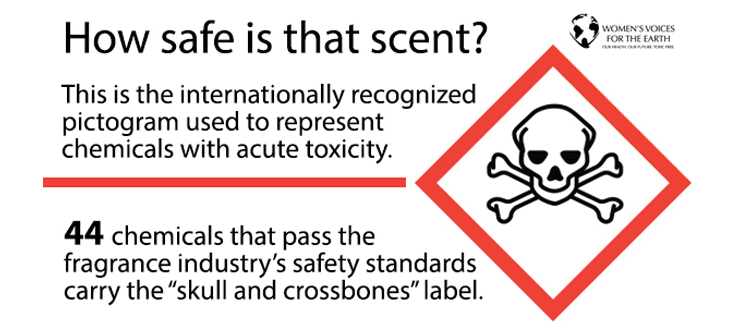Fragrance Industry Responds to Our Report on Safety Policy Failures
 |
|
Alex Scranton Director of Science & Research |
Our newly released fragrance report – Unpacking the Fragrance Industry: Policy Failures, the Trade Secret Myth and Public Health — has grabbed the attention of the fragrance industry.
A few days after we released our report, RIFM (Research Institute for Fragrance Materials) posted a statement on their website with a title inspired by our report, “Unpacking the Fragrance Industry: understanding the safety evaluation process”. (Think they chose that title to confuse consumers? So do I.)
We’re glad to see the fragrance industry paying close attention to the concerns outlined in our report about the failures of the industry’s self-regulating safety policy. Since fragrance is found in thousands of products we use on a daily basis from cleaning products to baby pacifiers, we expect the industry regulating this mega market to be tuned into the health concerns of its customers. But, if the fragrance industry is truly committed to providing a safe product, we have some major issues with their statement.
Let’s break it apart: the good, the bad and the stink.
(Note: quotes from the industry’s statement are in italics.)
The Good
“The fragrance industry believes that consumers should be confident that the products they buy are safe. Consumers today are aware of potential health and environmental issues and wish to make informed purchase choices.”
We fully agree with these statements. Making informed purchase choices means having simple information (ie ingredient lists) publicly available. Disclosing this information would go a long way towards building confidence in the fragrance industry’s products.
The Bad
“The full details of the RIFM safety evaluation process are publicly available in published form entitled Criteria for the Research Institute for Fragrance Materials, Inc. (RIFM) safety evaluation process for fragrance ingredients.”
This safety evaluation process has only been in place in its current format since mid-2015 when it was published. Very few fragrance ingredients have been run through this particular safety evaluation format. And certainly no controversial fragrance chemicals have been put through this process to test it out its validity.
“Established in 1966, RIFM has a long track record of scientifically sound safety assessment and methodology research.”
The bulk of this track record has been spent on addressing issue of skin sensitization from fragrance materials. Despite decades of focus and over 100 standards issued to eliminate skin sensitization, the rates of skin sensitization from fragrance have not decreased as a result of these efforts. In fact, in the U.S. skin sensitization to fragrance in adults increased significantly between in 2011-2012 compared to the previous decade.i
“In recent years, RIFM has intensified efforts to conduct full safety assessments on the ingredients used in the fragrance industry. Summaries of the assessments are made available through a peer-reviewed scientific publication. More detailed summaries are made available to RIFM members in order to help them with their own internal safety assessments.”
We appreciate the intensified efforts to conduct full safety assessments given that many of the older monographs on fragrance ingredients written by RIFM in the 1970s are out of date and currently of little value in ensuring safety. However, it is highly problematic that the new assessments are only available in summary form to the public. Largely the data these assessments are based on unpublished industry data. It seems greater detail on these assessments is only available to those inside the fragrance industry. Transparency and reproducibility are hallmarks of credible science, yet these values are not exemplified by RIFMs efforts in assessing safety.
“RIFM is a leading institution in advancing the methodologies used in ingredient safety assessments. These methodologies, including the RIFM-Creme Aggregate Exposure Model, the Quantitative Risk Assessment (QRA), the 2-Box Air Exposure Model, and the RIFM Environmental Framework, have met with very positive responses from regulators and other experts. These methodologies are all published.”
The Quantitative Risk Assessment (QRA) has actually met with skepticism from scientists that have reviewed its methodology and results. Specifically, The European Commission Scientific Committee on Consumer Safety (SCCS) had this to say about the quality of this methodology:
“The data provided show that the application of the dermal sensitisation QRA approach would allow increased exposures to allergens already known to cause allergic contact dermatitis in consumers. The model has not been validated and no strategy of validation has been suggested. There is no confidence that the levels of skin sensitisers identified by the dermal sensitisation QRA are safe for the consumer.”ii
The 2-Box Air Exposure Model has not been published as claimed. It is available on RIFM’s website, but only to subscribers to the database.iii
The Stink
“All of RIFM’s research is published and easily accessed in the public domain, on its website at www.rifm.org or its Online Open Source Fragrance Material Safety Assessment Center at http://fragrancematerialsafetyresource.elsevier.com/.“
This is simply untrue. Neither website provides any information on RIFM’s library of unpublished studies which are regularly cited in RIFM’s summary safety assessments. These basic research studies on fragrance materials, conducted by RIFM, have never been available to be reviewed by researchers outside the fragrance industry. This lack of transparency simply raises doubt on the validity of the science.
View examples
RIFM (Research Institute for Fragrance Materials, Inc.), 2014. In vitro skin absorption
of alpha-amylcinnamaldehyde. RIFM report number 67007 (RIFM,Woodcliff Lake,
NJ, USA).
RIFM (Research Institute for Fragrance Materials, Inc.), 1971a. Acute dermal toxicity
of 1-(para-menthen-6-yl)-1-propanone in rabbits. RIFM Report number 14582,
(RIFM, Woodcliff Lake, NJ, USA).
RIFM (Research Institute for Fragrance Materials, Inc.), 1971c. Appraisal of
sensitizing powers by maximization testing in humans. RIFM Report number
1805, June 21 (RIFM, Woodcliff Lake, NJ, USA).
RIFM (Research Institute for Fragrance Materials, Inc.), 1972a. Acute toxicity studies
in mice, rats and rabbits. RIFM Report number 2536, February 19 (RIFM,
Woodcliff Lake, NJ, USA).
RIFM (Research Institute for Fragrance Materials, Inc.), 1974a. Acute toxicity
studies. RIFM Report number 1778, January 24 (RIFM, Woodcliff Lake, NJ,
USA).
RIFM (Research Institute for Fragrance Materials, Inc.), 1974b. Report on human
maximization studies. RIFM Report number 1779, June 06 (RIFM, Woodcliff
Lake, NJ, USA).
RIFM (Research Institute for Fragrance Materials, Inc.), 1988a. Repeat insult patch
test of ethylene brassylate, methyl 2-nonynoate, 6,7-dihydrogeraniol and
cyclohexyl methyl pentanone in humans. RIFM Report number 6063,
December 13 (RIFM, Woodcliff Lake, NJ, USA).
RIFM (Research Institute for Fragrance Materials, Inc.), 2000b. 2-Week dermal
toxicity range-finding study with acetyl cedrene and alpha-methyl-3,4-
methylene-dioxy-hydrocinnamic aldehyde in rats. RIFM Report number
35257 (RIFM, Woodcliff Lake, NJ, USA).
RIFM (Research Institute for Fragrance Materials, Inc.), 2001a. In-vitro human skin
penetration of methyl eugenol, estragole, acetyl cedrene and OTNE. RIFM Report
number 37084, April 01 (RIFM, Woodcliff Lake, NJ, USA).
RIFM (Research Institute for Fragrance Materials, Inc.), 2001b. (14)C-OTNE:
Investigation of the transfer across the placenta and into milk of rats
during and after pregnancy following repeated oral administration. RIFM
Report number 38108 (RIFM, Woodcliff Lake, NJ, USA).
TAKE ACTION
Allowing industries to self-regulate is simply not in the best interest of public health. There are several things that need to happen to help ensure the safety of fragrance ingredients:
- Federal and state legislation is needed that requires product-specific disclosure of fragrance ingredients.
- Federal and state legislation is needed that requires fragrance to meet an unbiased standard of safety. Senators Feinstein (D-CA) and Collins (R-ME) recently introduced the Personal Care Product Safety Act (S.1014) that seeks to more stringently regulate ingredients in cosmetics. Unfortunately the bill continues to exclude fragrance from disclosure and meeting any real bar of safety.
- Manufacturers should voluntarily disclose fragrance ingredients on a product-specific basis. Some manufacturers like SC Johnson & Son, RB, and Clorox have already begun to disclose more fragrance ingredients.
- Manufacturers should develop and disclose their comprehensive toxic chemical screening process which details how they ensure the safety of their products, including their fragranced products.
For more information on fragrance ingredient safety, click here.
i. Warshaw EM, Maibach HI, Taylor JS, Sasseville D, DeKoven JG, Zirwas MJ, Fransway AF, Mathias CG, Zug KA, DeLeo VA, Fowler JF Jr, Marks JG, Pratt MD, Storrs FJ and Belsito DV. (2015) North American contact dermatitis group patch test results: 2011-2012. Dermatitis. Vol. 26, No. 1, pp: 49-59. Jan-Feb 2015.
ii. http://ec.europa.eu/health/scientific_committees/consumer_safety/docs/sccs_o_102.pdf
iii. http://www.rifm.org/rifm-science-assessment-tools.php#.VlY4H780NkU




Thanks for sharing this information. I wish I knew twenty years ago that Fragrance could cause significant health problems. Keep up the good work.